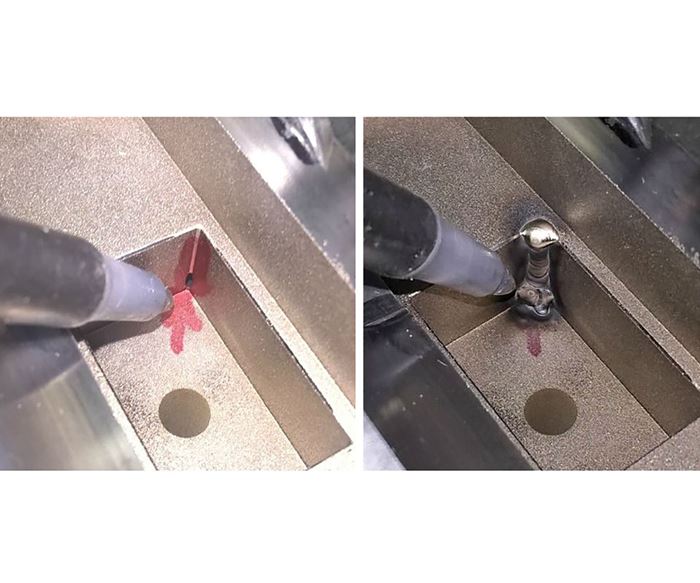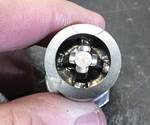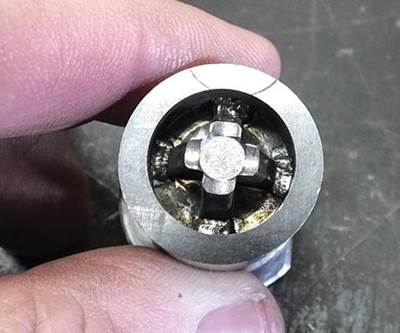Under the Scope: A Case for Micro-TIG Welding
Laser welding’s low heat output makes it the only viable choice for certain welding repairs, but it is not appropriate for all repairs. Micro-TIG offers its own set of benefits.
Laser welding’s low heat output makes it the only viable choice for certain welding repairs. It has even superseded micro-TIG welding in many ways. However, the question remains: “Can micro-TIG welding be completely replaced by laser welding?” The answer is no, and here are some reasons why:
Penetration and durability. Sometimes customers complain that laser welding does not penetrate as deep or adhere as well as micro-TIG welding. Adjusting the pulse width, power density and filler choices can help resolve these two challenges, however.
In my experience, the welding arc created in the micro-TIG process digs deeper into the base material, which is essential for filling holes and large damaged areas. Figure 1 shows an EDM pocket with a hole running along the corner that broke into a water line. In an instance like this, micro-TIG welding can melt deeper, which allows more weld to fill up the damage in the water-line hole.
Degree of damage and weld size. I use laser welding for small repairs such as weld buildups of 0.005 to 0.010 inch on molds and inserts. This is because the heat output of a micro-TIG process could cause damage. Laser welding is capable of handling much larger buildups, but in my opinion, that is an impractical use of the technology. In many repair situations, laser welding requires a longer weld time than micro-TIG welding because the welder is simply not adding the same amount of filler rod.
Laser welding also often needs a “smoothing” pass when the welding is done in multiple passes. To complete a smoothing procedure, the welder welds over a previously laser-welded area without adding rod to break any porosity. Each laser weld layer needs a smoothing pass before adding more rod. Unfortunately, this time-consuming procedure makes laser welding of large buildups an unreasonable application. Figure 2 shows a typical large micro-TIG-welding die repair. Micro-TIG welding is the faster and more efficient process to repair damage of this size.
Block size and ease of access. All laser welding must be done in a series of steps in order to be effective: Position the correct optical distance and laser pulse displacement, align the correct angle of the laser arm to reach optimum penetration, and correctly position the shielding gas.
Block size and position of the block for the laser arm should also be considered. This is where size can pose a challenge. Although laser arms allow some movement, it is not the same as that of a human wrist guided by a TIG-welding torch. Micro-TIG welding’s freedom of hand mobility allows the welder to access certain areas more efficiently and faster than he can with laser welding.
For example, there are times when I have spent 20 minutes lining up my laser on a large block and then have only welded for a few moments before needing to change position. If the repair is in a critical area, the additional time is probably worth it, but many times you can micro-TIG weld the block much faster and achieve the same result.
Contaminants. Anything that will be laser-welded must be critically clean. Any rough areas that are not removed prior to laser welding will cause problems. Micro-TIG welding creates a larger weld puddle, which can burn down problem areas. This gives the micro-TIG machine a distinct advantage over a laser welder in welding over contaminants and impediments such as rough steel, burrs and sharp areas.
Complementary processes. Another consideration is using the strengths of both processes on a repair in different steps. For example, look closely at the micro-TIG-welded piece in Figure 3 and notice the sink around the welded area. For this job, I laser welded the seam line around the area (where the micro-TIG weld meets the original steel) to fix any problems. My shop frequently uses this procedure to capitalize on the strength of micro-TIG welding and create larger and faster buildups, and uses a laser welder to fix the sink.
I use laser welding for at least 50 percent of my welding repairs, but laser welding is not appropriate for all repairs. Before selecting your method of choice, consider the advantages and disadvantages of both processes. Even if you brought mold repair in-house with a laser welding setup, it is important to keep in contact with a professional micro-TIG service, because eventually you will run into repairs that are more suited for micro-TIG welding.
Related Content
Laser Welding Versus Micro Welding
The latest battle in finely detailed restoration/repair of mold materials.
Read MoreExploring ISO 9000 - Part 16 Control of Quality Records
A Series of International Standards for Quality Management and Quality Assurance. We begin 2022 with a review of Clause 4.16 Control of Quality Records.
Read MoreSurface Finish: Understanding Mold Surface Lingo
The correlation between the units of measure used to define mold surfaces is a commonly raised question. This article will lay these units of measure side by side in a conversion format so that companies can confidently understand with what they are dealing.
Read MoreRevisiting Some Hot Runner Fundamentals
What exactly does a hot runner do? If you’ve been in the injection molding industry for any length of time, you might think the answer is obvious, but it is not.
Read MoreRead Next
Under the Scope: Considerations for Mold Repair Welding
This new series is intended to arm toolmakers and engineers with the necessary knowledge to make better informed decisions during tool repairs, including an understanding of welding terminology, procedures and challenges.
Read MoreHow to Use Strategic Planning Tools, Data to Manage the Human Side of Business
Q&A with Marion Wells, MMT EAB member and founder of Human Asset Management.
Read MoreHow to Use Continuing Education to Remain Competitive in Moldmaking
Continued training helps moldmakers make tooling decisions and properly use the latest cutting tool to efficiently machine high-quality molds.
Read More




















.png;maxWidth=300;quality=90)






